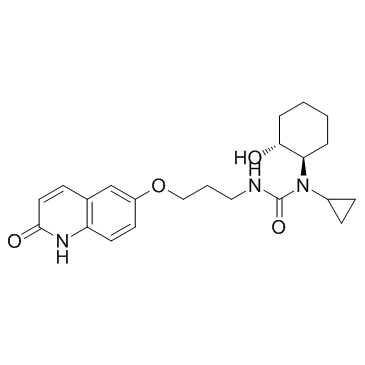| Description |
K134 is a phosphodiesterase 3 (PDE3) inhibitor. The IC50s of K134 toward PDE3A, PDE3B, PDE5, PDE2 and PDE4 are 0.1, 0.28, 12.1, >300 and >300 µM, respectively.
|
| Related Catalog |
|
| Target |
IC50: 0.1 µM (PDE3A), 0.28 µM (PDE3B), 12.1 μM (PDE5)[1]
|
| In Vitro |
K134 (K-134) inhibits rat platelet aggregation induced by collagen and ADP in a dose-dependent manner in vitro. The half-maximal (50%) inhibitory concentration (IC50) values of K134 are 2.5 µM and 3.2 µM, respectively. In vitro experiments, K134 also inhibits mouse platelet aggregation induced by collagen and ADP in a dose-dependent manner, and the IC50s are 5.5 µM and 6.7 µM, respectively[1].
|
| In Vivo |
K134 (K-134) significantly prolongs middle cerebral artery (MCA) occlusion time at doses >10 mg/kg, and reduces cerebral infarct size at 30 mg/kg in the stroke model (n = 12, 87.5±5.6 vs. 126.8±7.5 mm3, P<0.01), indicating its potent antithrombotic effect. The overall bleeding risk of K134 is assessed in general in mice. Single oral administration of K134 does not prolong bleeding time at a dose of 30 mg/kg compared to control (106±5 vs. 110±5 s, not significant). Moreover, a sufficiently high enough plasma concentration of K134 (13.6±2.3 µM) is detected to inhibit platelet aggregation at 10 min after single administration in mice at a dose of 30 mg/kg, which is the same time point as the above test of bleeding time. Next, the effects of PDE3 inhibitors on thrombus formation are also investigated in an arteriovenous shunt model in rats. K134 significantly reduces the incidence of occlusive shunt thrombi at doses above 10 mg/kg (half-maximal effective dose: ED50=11 mg/kg). The plasma concentration of K134 is 0.43±0.08 µM (Cmax) at a dose of 10 mg/kg[1].
|
| Animal Admin |
Mice[1] Male ICR mice, 5-8 weeks old, are used. K134 (K-134) and Warfarin are suspended and dissolved in 1% HPMC, respectively, and orally administered to ICR mice at 10 min or 24 h before testing of bleeding, respectively. Each mouse is placed in a restrainer, which exposes the tail. A 27G disposable needle is inserted about 6 mm into a tail vein 2 cm from the tip of the tail. Immediately after the operation, sheets of filter paper are placed under the injury site every 15 sec to absorb the blood, and the time point at which no blood is observed on the filter paper is regarded as the bleeding time.
|
| References |
[1]. Yoshida H, et al. K-134, a phosphodiesterase 3 inhibitor, prevents brain damage by inhibiting thrombus formation in a rat cerebral infarction model. PLoS One. 2012;7(10):e46432.
|
